Maintain long-term reliability with the right clp engine.
Maintain long-term reliability with the right clp engine.
Blog Article
How a Clp Engine Can Boost Performance in Numerous Industries
The advent of CLP engines notes a significant shift in functional effectiveness across numerous markets, driven by their capacity to maximize fuel consumption and reduce downtime. Industries such as manufacturing and logistics stand to acquire significantly from their durable layout and regular power output, which promise to streamline procedures and boost performance. As organizations significantly focus on sustainability along with effectiveness, the function of CLP engines becomes a lot more essential. What continues to be to be seen is just how these advancements will shape the future landscape of commercial procedures and their effect on wider financial patterns (clp engine).
Review of CLP Engines
CLP engines, or Constant Fluid Propellant engines, stand for a substantial innovation in propulsion modern technology, particularly for room applications. These engines utilize a continual feed system that enables the sustained expulsion of propellant, leading to improved effectiveness and performance compared to traditional strong or hybrid propulsion systems. By maintaining a continuous circulation of fluid propellant, CLP engines can accomplish much more specific thrust control, which is essential for maneuvering spacecraft in numerous goal scenarios.
The design of CLP engines incorporates advanced materials and cutting-edge gas management systems. clp engine. This results in decreased weight and boosted dependability, crucial aspects for long-duration space objectives. Moreover, the continuous operation minimizes the danger of combustion instability, a typical difficulty in traditional rocket engines.

Advantages in Production
The production of Continual Fluid Propellant (CLP) engines offers numerous remarkable advantages that improve both performance and cost-effectiveness. One of the main benefits is the streamlined production process, which lowers the complexity related to typical propulsion systems. By using liquid propellant, suppliers can achieve better accuracy in engine performance, resulting in optimized power result and minimized waste.
Furthermore, CLP engines help with a higher level of modularity, enabling easier assimilation right into different manufacturing lines. This adaptability can significantly decrease preparations and improve overall operational flexibility. Making use of CLP innovation likewise often tends to decrease the demand for extensive upkeep as a result of less relocating components, which translates into reduced downtime and operational costs.

Applications in Logistics
Leveraging Continuous Liquid Propellant (CLP) engines in logistics offers significant advantages in operational efficiency and dependability. These engines supply a durable solution for various transportation needs, allowing the smooth activity of products throughout large distances. The integral layout of CLP engines permits for regular power result, which converts right into smoother and much more foreseeable transport timetables.
Among the key applications of CLP engines in logistics remains in durable products transportation, where they can drive both ground and airborne automobiles. Their ability to preserve high performance under differing tons problems ensures that delivery timelines are satisfied, thus enhancing customer complete satisfaction. In addition, CLP engines can be incorporated right into automated logistics systems, assisting in real-time tracking and maximizing path preparation.
Additionally, the toughness of CLP engines decreases upkeep downtime, allowing logistics firms to maximize their operational abilities. This is particularly beneficial in warehousing procedures, where efficiency in handling and delivering products is critical. As logistics remains to develop, the assimilation of CLP engines represents a forward-thinking approach that go to website not just improves efficiency but additionally supports the sector's growing needs for dependability and speed.
Influence on Energy Performance
Exactly How do Continuous Fluid Propellant (CLP) engines improve power effectiveness in transport? CLP engines use a consistent flow of fluid fuel, optimizing burning processes and keeping a secure thrust output. This layout lessens energy losses connected with typical burning engines, where gas shipment can differ and cause inefficiencies.
The constant operation of CLP engines enables an extra efficient thermal cycle, causing greater certain impulse compared to conventional engines. clp engine. This equates to lowered fuel usage for the very same quantity of work done, considerably lowering operational prices across numerous transportation markets, including air travel and maritime industries
In addition, the ability of CLP engines to preserve optimum efficiency under varying load conditions minimizes the demand for frequent acceleration and deceleration, even more boosting gas efficiency. Improved energy performance not just adds to cost savings but also results in reduce greenhouse gas discharges, straightening with international sustainability objectives.
Future Trends and Innovations
Arising developments in Continual Liquid Propellant (CLP) engine innovation assurance to transform the landscape of transport efficiency and sustainability. As sectors pivot towards greener options, CLP engines stand at the center, incorporating ingenious materials and layout methodologies that enhance efficiency while reducing environmental influence.
Among one of the most appealing patterns is the fostering of hybrid systems that incorporate CLP engines with renewable resource sources. This harmony can enhance fuel consumption and reduce emissions, aligning with worldwide sustainability objectives. Furthermore, improvements in computational fluid dynamics (CFD) are facilitating the layout of even more aerodynamically efficient engines, causing lowered drag and improved fuel site here performance.
Moreover, the advancement of smart tracking systems is readied to boost operational effectiveness. These systems leverage information analytics and IoT modern technology to enhance engine efficiency in real-time, making sure that the engines run within their most efficient parameters.
As research study proceeds to discover alternative propellant formulas-- such as biofuels and synthetic gas-- the future of CLP engines looks encouraging. By harnessing these innovations, industries can not just boost their effectiveness but likewise add considerably to a cleaner, a lot more sustainable future in transport.
Verdict
In conclusion, CLP engines stand for a substantial innovation in performance throughout several click over here now markets. The combination of innovative products and fewer moving parts minimizes upkeep needs, while positioning with sustainability goals positions CLP engines as a pivotal modern technology for the future.
Report this page